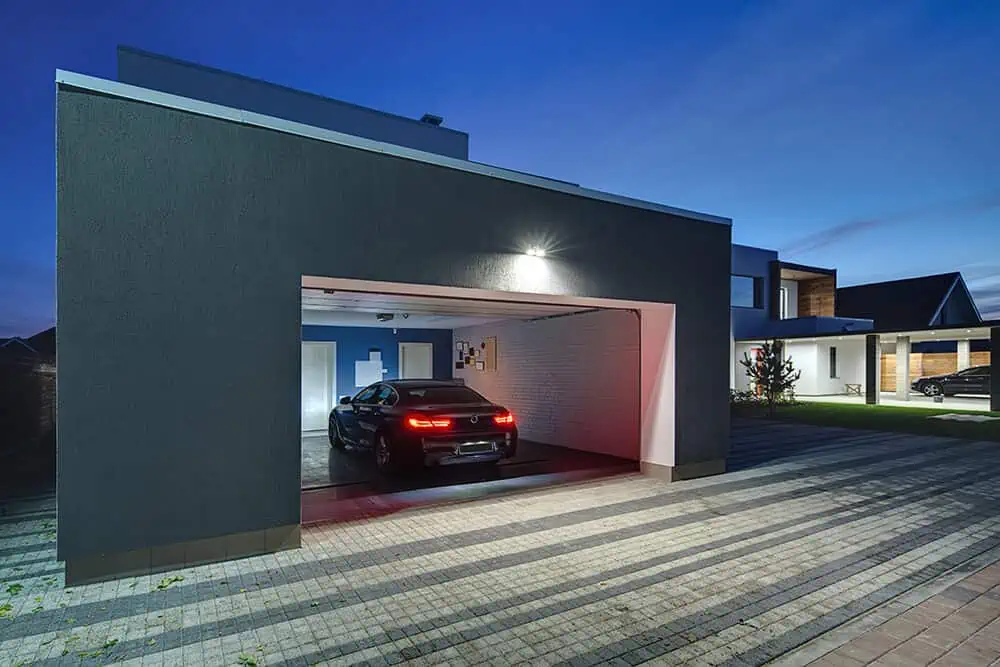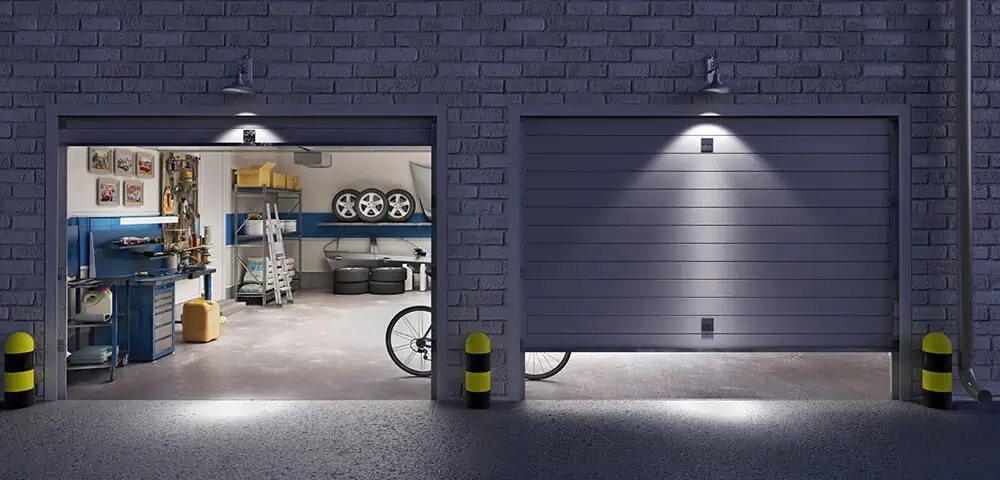The utility of a garage is more than just parking a vehicle. You store tons of stuff in it, and the minor repairs of everything in a household are typically carried out in these spaces. That said, you can maximize the utility of the garage only if it features well-designed lighting. There is more to lighting a garage than installing incandescent bulbs, which is precisely what this article tries to explain.
So, let’s dive into it and understand what makes garage lighting important and what options you have to light a garage effectively.
Why Should You Improve Garage Lighting?
To understand why you must light a garage appropriately, you must understand what makes it so important. See, the garages are typically used for parking cars, which does not require you to put too much thought into the lighting. While car parking is a major purpose, it is not the only function of a garage. You will also use it to store equipment, supplies, and other household stuff. It will make the garage an important part of the home, which serves beyond offering just a parking space for your car. Thus, like every other area of the house, you will have to put your thoughts and effort into lighting it up properly.
Lighting the garage effectively will enhance its utility. You would not have to use portable LED lights while doing quick repairs in the garage. Furthermore, it will make it easier to store and access supplies. A well-lit garage prevents safety hazards while you are engaged in quick repairs. You can see everything clearly; thus, the risk of nasty falls and injuries is greatly reduced.
A well-lit garage will also make it easier to park and take the car outside without scratching it with the walls of a small garage. Hence, If you want to upgrade a garage, you should always start with the lighting.
Different Types of Garage Lights
While looking for light fixtures for a garage, you will come across various options. It is important that you know the ins and outs of each option before making a decision. Let’s look at them.
1. LED Garage Lights
LEDs or Light Emitting Diode should be your first preference while lighting your garage. The main benefits of LEDs are that they use much less energy than incandescent and fluorescent bulbs and have much longer lifespans. Typically, LEDs consume about 75% less energy than traditional incandescent bulbs. Furthermore, the lifespan of the LEDs is more than 80% of conventional bulbs.
By installing LEDs in your garage, you are not only reducing your power consumption but also sparing yourself from the trouble of having to replace bulbs now and then. Another benefit of LEDs is flexibility in terms of variety. You can get various types of LED fixtures of different sizes and shapes. The combination of these fixtures can be used to create an effective lighting design for a garage.
The only downside to using LEDs in the garage is they are unidirectional. It means the light coming from LEDs goes in one direction only. Thus, if you have to light the entire garage appropriately, you must use multiple LED fixtures.
2. Fluorescent Lights
Fluorescent Lights work best for illuminating large areas. You can use them if you have a small-scale or a commercial garage. Such lights feature a tube shape that is based on mercury vapors. Light is produced as the mercury within these fixtures is ionized with the current passing through them. In addition, the tubes also have inert gas and phosphorous coating within them.
The main benefit of these lights is they emit diverse wavelengths, which makes them appropriate for lighting up a large area. You will also have to get ballasts to make these fixtures bulbs.
While the ionization of mercury produces bright light, the heat generated by it also damages the quality and functionality of the fixture. It is despite the fact that mercury liquefies when the temperature falls down. Hence, the life of such lights is shorter than LED bulbs.
3. Incandescent Light Bulbs
Incandescent light bulbs are popular mainly because of their low prices. These are the cheapest solution for various light spaces, including washrooms, bedrooms, patios, and garages. Such lights use a heating filament that illuminates the area as the current flows through it.
That said, despite being inexpensive, such bulbs are the least practical option for lighting any space. For starters, the filament in these bulbs is very delicate, and after a few hundred hours, it breaks down. The only way to fix this is to get a new bulb, which means you will have to replace them frequently. Secondly, they require high wattage and draw more energy, which increases your energy bills significantly.
4. Halogen Lights
The fundamental design of Halogen light is the same as incandescent bulbs, but they are a little more advanced. Most people prefer them because they emit white light, which is easier on the eye as it does not produce any strains. Furthermore, the energy consumption of Halogen lights is significantly lower than that of incandescent bulbs, and so is the lifespan.
That said, when compared with LEDs, Halogen lights need to catch up as they consume more power and are less durable.

Benefits of Garage Lights
Lighting a garage with appropriate fixtures and design will offer various benefits. The important ones of them are the following:
1. Enhanced Utility
As discussed earlier, the function of the garage goes beyond storing vehicles which are achieved only if it has adequate lighting. With appropriate lighting, the garage can be converted into a workspace where minor vehicle repairs and other electronics can be carried out.
An excellent lighting design will also make the work in the garage more streamlined. You will be able to see what you are working on more clearly, reducing the chances of errors. Furthermore, even if a small component accidentally falls out of its place, you will be able to spot it thanks to the great lighting in the area.
2. Longevity
This benefit concerns more to commercial garage owners who have to keep the lights on for extended periods of time. With a suitable solution in place, you would not have to replace the fixtures frequently, even if you keep them on throughout your working hours. Furthermore, good lighting will attract more customers and help you generate more profits.
Another benefit of good lighting in commercial spaces is it keeps the staff alert. Light plays an important role in influencing moods. While a well-lit area keeps the staff motivated and alert, the dull lighting condition will make them feel drowsy, which impacts the performance of a commercial space.
3. Cost Benefit
An efficient lighting solution is also cost-effective as it draws less power and saves money on energy bills. While it benefits domestic garages, it also impacts commercial spaces more. Unlike domestic garages, the lights in commercial garages must be kept on for longer. Hence, the energy bills can pile up if the fixtures draw more power. In contrast, the cost-effective solution will save decent capital that can be used to enhance the productivity of a business.
For example, incandescent bulbs use about 80% more energy than LEDs. It means by installing the LEDs, you are reducing your energy bills by 80%, provided that lights are the top consumer of electricity in your commercial space.

How to Light a Garage Properly
Now that you are familiar with the basics of garage lighting and understand the options out there, let’s discuss the factors that must be considered while lighting a garage.
1. Determine The Right Fixture
The first step in lighting a garage is the fixture choice; as discussed earlier, there are many options. While LEDs are the ideal choice for most garages, some might prefer other fixtures for different reasons. We have discussed popular fixtures in detail, so you can figure out which fixtures work the best.
It is important to pick the fixtures before finalizing the design because all light types have unique characteristics, which play a key role in determining how the lighting in the garage will look. For example, incandescent bulbs emit yellowish light, while LEDs generally have a whitish shade. So, both of them will offer a different appearance to a garage. You will have to figure out the desired appearance of the garage before picking a fixture.
More information, please read Halogen vs. LED Bulbs: How To Choose?
2. Figure out Your Light Output
The light output of a bulb is measured in lumens – the higher the lumens, the brighter the light. Different spaces have varying light requirements, but as a general rule, 5 lumens per square foot work for most garages. To find out the number of lights, you will need in your garage, multiply five by the total square feet of your garage.
Once you get the exact figure, start looking for fixtures that can deliver the amount of light that is needed by your garage. Be mindful that most times, especially with LEDs, you must use multiple fixtures to ensure every part of the garage is illuminated.
3. Figure out Color Temperature
Color temperature is the measure of light’s color, and it is based on the kelvin scale, which ranges from 1,000 to 10,000. In addition to determining the color of light, the color temperature also impacts the mood of occupants and the overall vibe of a space. For example, lights with temperatures below 3,000K offer a warm light, creating a cozy atmosphere that is unsuitable for a workspace. In contrast, the lights with a color temperature of more than 4,000K are on the cooler side of the spectrum and mimic the natural light, which makes the occupants feel alert.
Thus, while looking for a lighting solution for a garage, it is best to go with fixtures that have a color temperature of around 5,000K.
4. Color Rendering Index
Have you ever been to a store and looked at an item, but as soon as the same item was brought under natural light, it started to look different? It is because the color rendering index of the lights installed in that store was low. The color rendering index measures how well light can mimic natural light in terms of showing the true colors of objects under it.
Like the color temperature, it is measured on a scale that ranges from 0-100. The closer you get to 100, the color will start to look more natural, or at least how they look under natural light. You should look for lights that have a CRI of more than 80 to light a garage effectively.
5. Understand The Effect of Light on Different Wall Colors
While looking for a lighting solution for your garage, you must also factor in the colors of your walls. The walls that have brighter colors reflect light, and thus solutions with low lumens will also work. In contrast, the walls with a darker finish will absorb light, requiring you to install fixtures that offer more lumens.
Tips to Improve Your Garage Lighting
If the lights in your garage look rather dull, the following tips will help you improve them;
- Use Combination of Lights: Lighting in any space can be divided into three categories, ambient, task, and accent lights. All three of them are important and should be installed in a garage to maximize their utility.
- Select Appropriate Fixtures: Ambient, task, and accent lights require different types of light fixtures, which must be picked correctly to ensure a good lighting design in a garage.
- Use LEDs: LEDs are cost-effective as they draw much less energy and last longer than traditional bulbs. Furthermore, a variety of LEDs can help you achieve an efficient lighting design for the garage.
- Always pick higher CRI: While working in the garage, you need to see objects exactly how they look in natural light. It can be achieved by using fixtures with higher CRI.
- Install motion sensors: Motion detectors can turn the lights on and off by detecting the movement in the environment. By turning off lights when they are no longer needed, they can save a lot on energy bills.
FAQs
Yes, LEDs are ideal for the garage because they consume far less energy than traditional bulbs and last longer. The upfront cost of the LEDs is expensive, but they make up for it with their performances.
The lights used in the garages should have color temperatures of around 5000K. The lights emit cool light in this color, which works best for workspaces.
The typical size of a 2-car garage is about 400 square feet, and 5 lumens per square foot are enough for most garages. Thus, on average, a 2-car garage will require 2,000 lumens of light.
You should not leave the lights on all night because it makes the intruders think you are not at home. Instead, use motion sensors that turn the light as soon as they detect the motion. They will deter intruders while preserving electricity.
Based on the type of fixture, the lights in the garage can be located on walls, ceilings, or over the cabinets that are used to store equipment and supplies.
LEDs are expensive compared to other light fixtures, but the amount of money they save on energy bills and their longer life span make them worth it.
You will need multiple LEDs in a garage. The exact number depends on the area and the type of fixture you want to use in a garage.
Conclusion
The garage is an important part of a house, and like living rooms, bedrooms, and washrooms, it must be illuminated properly to ensure utility. It is even more important for the garages of commercial spaces. You have to look for lighting solutions that ensure maximum utility without driving up the cost of energy bills. We hope this article has conveyed the options that can help you achieve that.
LEDYi manufactures high-quality LED strips and LED neon flex. All of our products go through high-tech laboratories to ensure the utmost quality. Besides, we offer customizable options on our LED strips and neon flex. So, for premium LED strip and LED neon flex, contact LEDYi ASAP!



